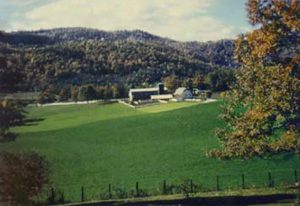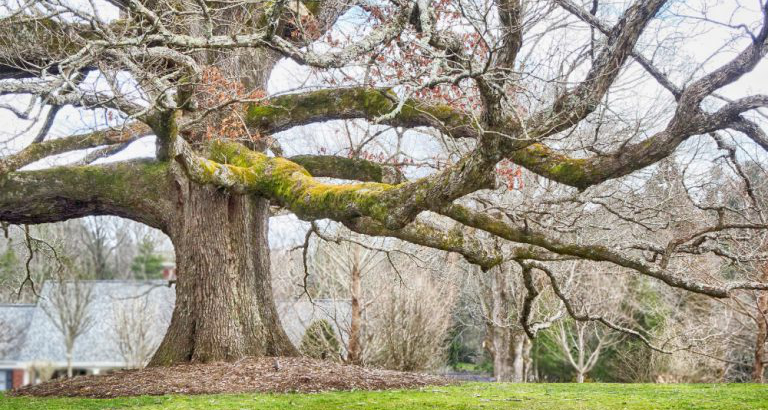Excerpts from
“A Personal History:
Mayfields Farm to Hawthorn Hills”
Written in Spring, 2000 by Virginia Browning Turner
daughter of Bert & Sara Browning
I remember those times when life was slower, gentler. In many ways, it bound people together. For instance, milk wasn’t something you picked up off a rack at the supermarket. Your friendly milkman delivered it, along with real cream and butter. And he never forgot to carry treats for the kids and dogs along his route.
In 1943, Bert Browning and his wife, Sara, decided to expand the scope of their business, a local dairy farm and processing plant called Kalmia Dairy. They purchased the Hicks McCrary dairy farm located on Brevard Highway about three miles west of Hendersonville, NC. This new property consisted of 103 acres with a large farmhouse next to the oldest oak tree in the area. Two barns and four small tenant houses stood nearby.

Since the farm and Kalmia Dairy were both bought in the month of May, and Bert and Sara’s anniversary was also in May, they renamed their new acquisition Mayfields Farm. Some 70 Guernsey and Holstein cattle grazed the well-tended pastures. White board fences soon replaced barbed wire. Three more barns and two silos were added. The one barn that remains today was a feed barn. The flooring in the loft was laid of hardwood for the square dances that were enjoyed in summer, before the hay was dried and stored. For most dances, the music was from a PA system and a 78 rpm record of “Down Yonder” performed by the Skillet Lickers.
Brevard Highway was four feet narrower in the 1940s than it is today. With wider shoulders and much less traffic, we rode horses along it without any safety concerns. For training, there was a riding ring next to the stream behind the house at 210 Heathcote Road.
A part of the original entrance road to the barns is now the only private driveway that extends directly up from Brevard Highway. During WWII, groups of German prisoners held in Henderson County were sent out to work on farms. And until 1962, when Bert decided to dress it up with a rock facing, you would have seen the initials “P.O.W.” on the concrete culvert under that driveway, a legacy of the young Germans who installed it.
“…the next few years were spent planning the subdivision we now enjoy.”
Bert sold Kalmia Dairy in 1957, including the cattle on Mayfields Farm. But not the land. He had always said the rolling hills were more suited to a development than to farming. So the next few years were spent planning the subdivision we now enjoy.
The purchase of 97 acres of wooded area, now Heathcote Road, brought the total acreage to 200. William Pitkin, an architect known for laying out Shaker Heights in Ohio, was hired to plat the roads and the lots. It was Mr. Pitkin who gave Bert and Sara the idea for the subdivision’s name when he said he’d never seen so many hawthorn trees in one place. Bert was pleased with the the new name, Hawthorn Hills, but was forever bothered by people who insisted on adding an “e” to the end of Hawthorn. Nathaniel might have been pleased, but Bert was not.
Lake Archer was built in 1962. In 1963, the first part of Hawthorn Drive was graded and paved. It went from the highway to the barn while at the same time Browning Road was established as far as the driveway for 309 Browning. Bert built the first house in 1963 at 110 Hawthorn Drive. Over the years, he was the contractor for 16 homes. Some were spec homes to set the tone of the area, but most were built for specific owners.
By design, Hawthorn Hills developed slowly. For 30 years, no more than two lots were sold in any single year. Bert loved the land and since it carried a cost basis of farmland, he had an excuse to sell it off very slowly.
Three more separate stages of development followed the first. In about 1969, Heathcote Road and Gregory Way were put in, and Browning Road was extended to meet them. In 1977, the “meadow road” was built, extending Hawthorn Drive from the barn around to meet Browning Road. Then Riding Gate Road and the rest was established in 1993.
Hawthorn Hills had a private water system until 1990. At first, the water came from a spring above Lake Virginia that fed two large reservoirs and flowed by gravity feed to the residences. In 1973, the spring water was augmented by well water. As demand became heavier, the pump house on Heathcote was built, and we tapped into the Hendersonville City Water System. Bert made sure that all residences had meters approved by the Water Department, and it was my job to read them each month and take care of the billing. In 1990, however, the cost to Browning Enterprises became prohibitive. The Utilities Commission would have approved significantly higher rates, but we decided to give the pump house and system to the City of Hendersonville, rather than place this burden on the residents.
“The Hawthorn Hills family grew and thrived.”
It was back in 1965 that Sara and Bert built their dream home at 304 Browning Road. The brick from the milking barn was used in its construction. Leaded panes from a small cottage at the site of 116 Hawthorn Drive flanked the new front door. Other fine items from various places were incorporated into the house, and it was filled with fine antiques. Bert and Sara joked that they should call the house “Leftovers.”
Working in her yard was Sara’s love. The grounds were a showplace and Sara could be seen every morning, weather permitting, tending the yard and visiting with those passing by. Surely, Bert and Sara share our pleasure that it is now owned and loved by their grandson, Parker Browning.
Sara also developed and tended the plantings at the entrances to Hawthorn Hills, along the highway, and around Lake Archer. While Sara gardened, welcomed new residents, and gave memorable parties, Bert also kept very busy. He rode through the subdivision each day making sure everything was shipshape and not a single stray limb had fallen to mar the landscape. With loving care over the years, Bert saw to the maintenance of the roads, lakes, entrances, and common grounds. All building and site plans had to meet with his approval, and contractors were often reminded that no trash was to be scattered around a building site. He even knocked on doors and asked residents to adhere to his high standards. He was fondly known as the “Benevolent Despot.”
The Hawthorn Hills family grew and thrived. The first 4th of July picnic was held in 1978, under our grand old oak tree, followed that December by the first Christmas gathering at the Hendersonville Country Club. The lunch that year was $6.50 per person, including champagne!
Beloved by all who knew her, Sara passed away in 1983. Bert stayed on in their home. He continued his active life in the community, although by that time most of the running of the subdivision had been taken over by his children – Bert III (Downtown Bert) and me. Even after he was no longer able to drive on the highways, Bert was seen each day driving through Hawthorn Hills to be sure all was in order.
The last home that Bert built was a custom home at 302 Browning Road, in 1987. As always, he expected the carpenters to be on the job and working at 8:00 am. Coffee and smoking breaks were definitely not necessary in his estimation, particularly since he himself was on the job for the entire day with only a short break for lunch. Bert was 86 at the time.
In 1996, Bert suffered a bad fall that made it necessary for him to reside in an assisted care facility. However, after recovering, he came out during the day and continued to build the fine furniture in his workshop that had been his hobby since 1944. Bert passed away the next year at the age of 96. His long and full life was celebrated with a large memorial service held near the old oak tree where the original farmhouse had stood. An era had come to a close.

It is the hope of the Browning Family that each of you enjoys the fruits of our labors and that you have many happy years as residents of Hawthorn Hills. In the words of the late Frank Ewbank, on the occasion of Bert’s 95th birthday:
“We all know Bert,
he’s mostly merry.
Bought some cows for his Kalmia Dairy.
Then bought some pasture
so his cows could feed
and bought the land
lock, stock and deed.
Sold that land to the Jacks and Jills;
today we call it Hawthorn Hills!”